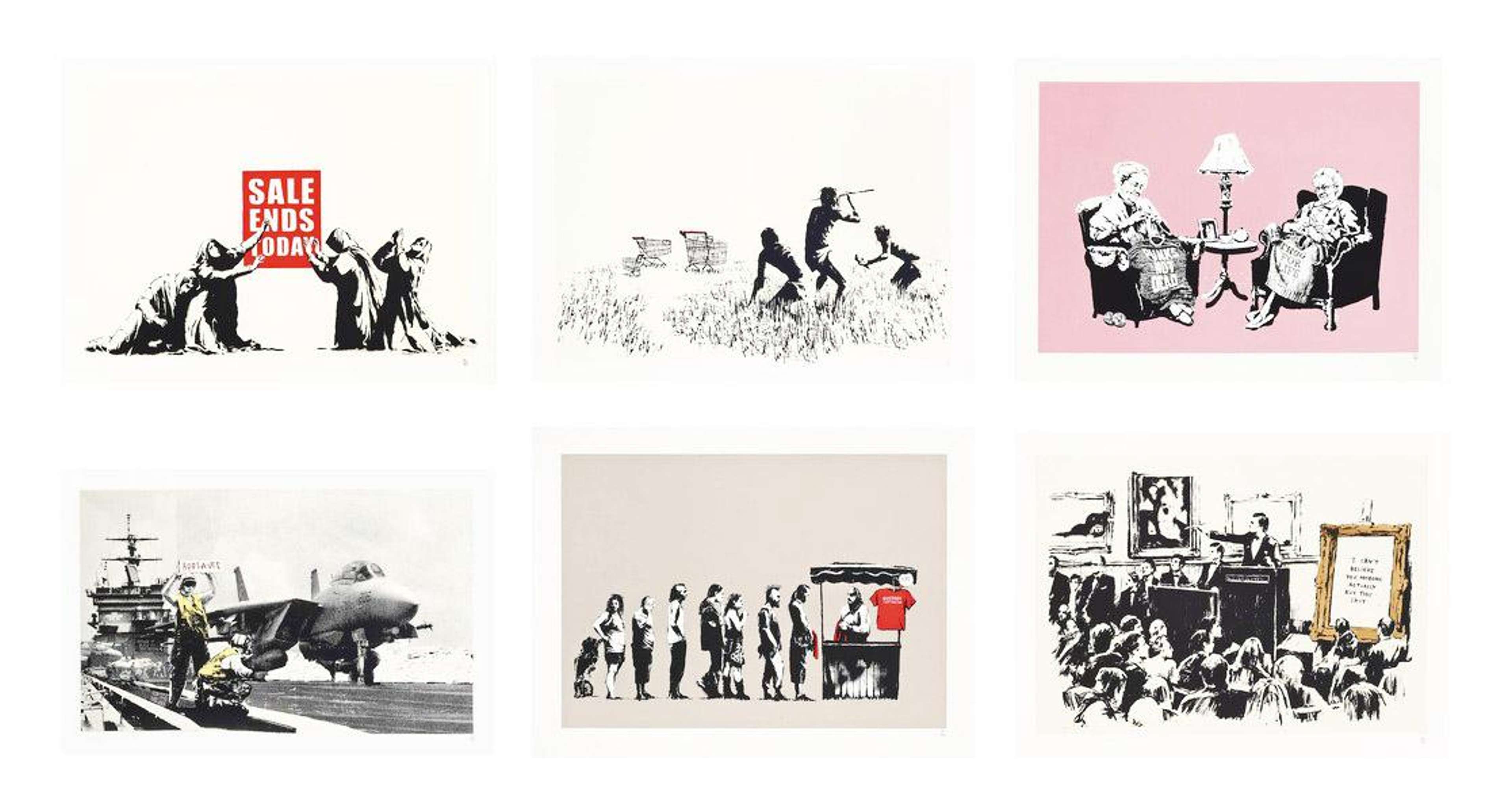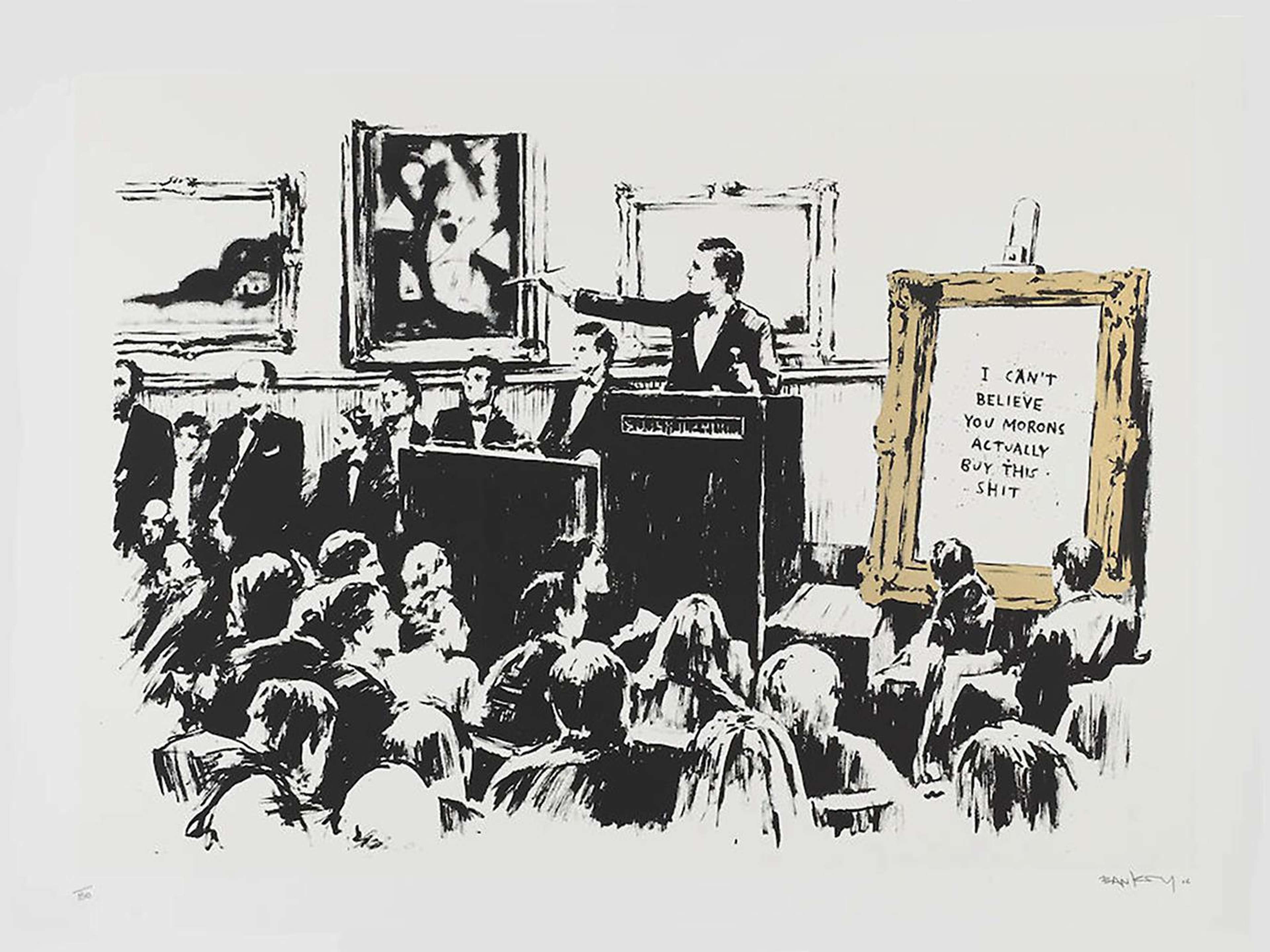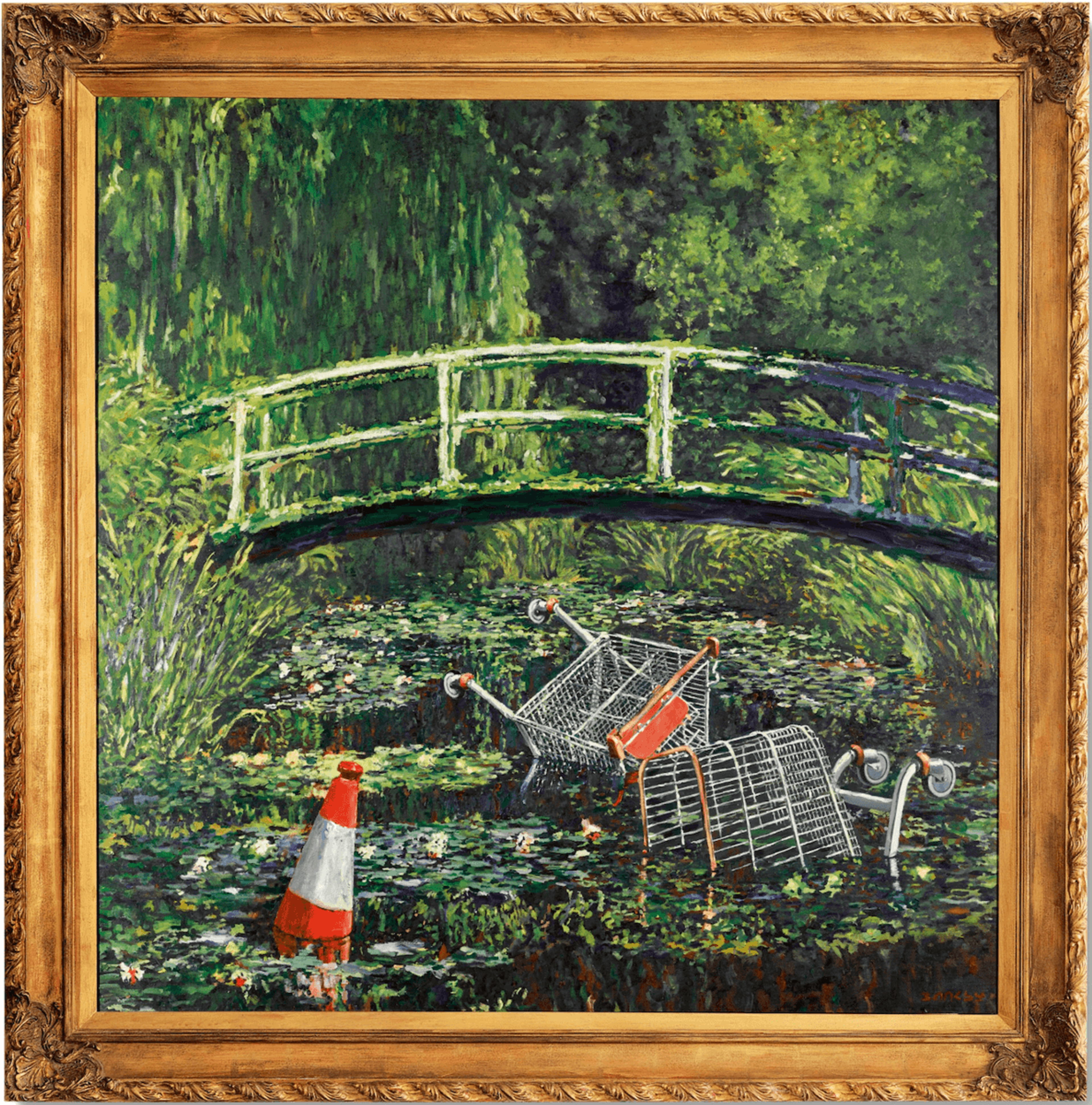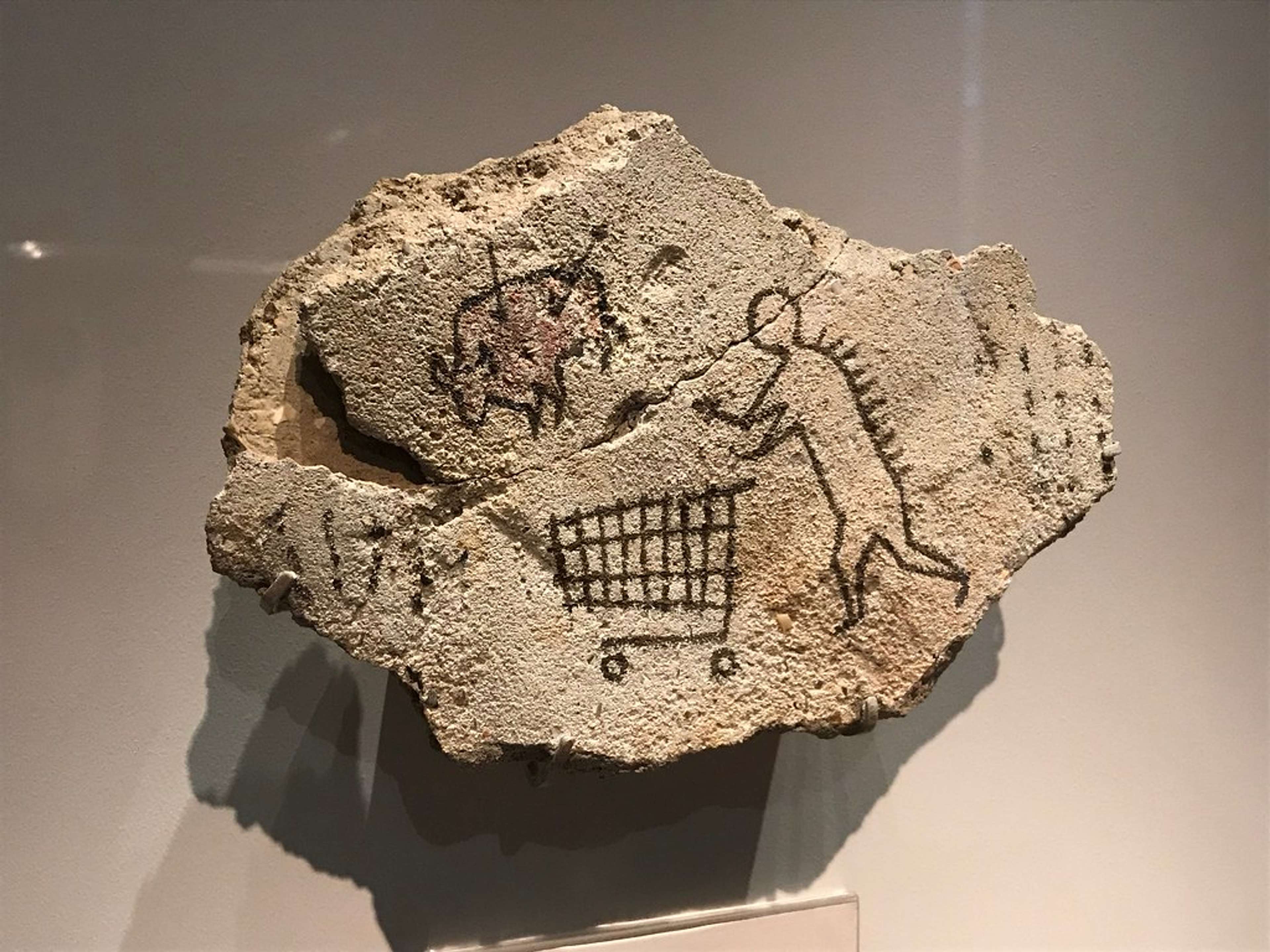 Trolley Hunters © Bansky 2007
Trolley Hunters © Bansky 2007
Banksy
269 works
Trolleys or Trolley Hunters is one of the most iconic Banksy prints, that touches upon themes of materialism and capitalist dependency.
To learn more about this series and Banksy's regular use of the shopping trolley motif, see our 10 facts here:
Trolleys was first released under a different name
 Image © cliffwilliams / Trolleys © Banksy 2006
Image © cliffwilliams / Trolleys © Banksy 2006In 2006, Banksy held a momentous exhibition in Los Angeles called Barely Legal, which set the standard for street art exhibitions at the time and firmly established the artist’s name and reputation. His artwork Trolleys was released for this show as an original painting and a series of screen prints, which were originally titled Trolley Hunters.
What is the meaning of Banksy's Trolley Hunters?
 Trolley Hunters (Special Edition) © Banksy 2007
Trolley Hunters (Special Edition) © Banksy 2007Like many of Banksy’s works, Trolleys is open to interpretations: some see the print as a comment on society’s desire to ‘hunt down’ and own symbols of shops and brands, while others see the print as a reflection on how society has changed because of consumerism – we no longer have the means to grow our own food, so rely on the big corporations to provide it for us.
Trolleys was released as part of Banksy’s Barely Legal set
 Barely Legal LA Set © Banksy 2006
Barely Legal LA Set © Banksy 2006At Banksy’s Barely Legal exhibition, visitors had the chance to buy a special portfolio called Barely Legal (LA Set), which contained Trolleys, Grannies, Festival, Applause, Sale Ends, and Morons. Although 500 unsigned prints of each series were made, only 100 were released for the exhibition – making the Barely Legal prints among the artist’s rarest and most sought-after editions, and even more valuable when sold as a complete set.
After Barely Legal closed, Los Angeles-based printers Modern Multiples were ordered to destroy the plates for the six prints, so they could never be reproduced without the involvement of Banksy’s UK-based printer at the time, Pictures On Walls.
How many colour variations of Trolleys are there?
 The rarest colourway, this print is one of only 150. (Trolley Hunters (Special Edition) © Banksy 2007)
The rarest colourway, this print is one of only 150. (Trolley Hunters (Special Edition) © Banksy 2007)There are four differently coloured versions of Bansy's Trolleys. In addition to the Barely Legal edition, Banksy’s printers Pictures On Walls also released Trolleys in three other colourways in 2007: 750 signed colour prints with a blue and yellow background, and 500 unsigned white prints and 150 signed white prints with a red detail on the trolley handles.
The Pictures On Walls Trolleys came with another difference
 Left: Trolley Hunters (LA Edition) © Banksy 2006; Right: Trolley Hunters © Banksy 2007
Left: Trolley Hunters (LA Edition) © Banksy 2006; Right: Trolley Hunters © Banksy 2007In the original Barely Legal prints, the caveman on the right wields a club. In the 2007 Pictures On Walls versions, the same caveman is seen holding a makeshift wood and stone hammer.
A rare edition was sold at Banksy’s Santa’s Ghetto Pop-Up
 Trolley Hunters (Special Edition) © Banksy 2007
Trolley Hunters (Special Edition) © Banksy 2007Later in 2007, at Banksy’s Santa’s Ghetto pop-up shop in Bethlehem, visitors had the opportunity to buy a special edition of Trolley Hunters (Bethlehem Edition). Only 28 signed prints exist. In a move that deepens the artwork’s anti-capitalist message, they were all printed on end paper - a heavier, uncoated & less refined stock.
What’s the record sale for a Trolleys print at auction?
 Morons © Banksy 2007
Morons © Banksy 2007The most expensive print in the Trolleys series is a Trolley Hunters (Colour), sold for HK$1,008,000 with fees (£96,531) in a Hong Kong auction on 4 December 2020. Just days later, another edition of the print sold for close to the same amount – £91,000 with fees – in London on 7 December 2020.
A Banksy Trolleys print was stolen from an exhibition in 2018
 Trolley Hunters (colour) © Banksy 2007
Trolley Hunters (colour) © Banksy 2007A print of Trolley Hunters (Colour) was stolen from an unauthorised exhibition of Banksy’s art in Toronto in 2018. The show – curated by Steve Lazarides, Banksy’s former agent – displayed more than 80 works owned by private collectors. CCTV footage from the set-up of the exhibition showed a man creeping out with print in hand. Many on social media have speculated that it was Banksy himself who stole the artwork.
Shopping trolleys have appeared in other Banksy artworks
 Banksy's spin on Monet's Water Lilies depicts trolleys littering the pond. (Image © Sotheby’s / Show Me The Monet © Banksy 2005)
Banksy's spin on Monet's Water Lilies depicts trolleys littering the pond. (Image © Sotheby’s / Show Me The Monet © Banksy 2005)In another artwork, Banksy has used the shopping trolley as a symbol for destructive and wasteful capitalism: Show Me the Monet features two discarded shopping trolleys thrown into Claude Monet’s famous waterlily pond at Giverny.
Though Banksy has faithfully captured the impressionist style of the original masterpiece, the jarring addition of two upturned shopping trolleys reflects how damaging consumer culture can be to the beautiful natural world.
The painting sold at auction at Sotheby’s for £7.5 million in 2020.
Banksy sneaked a painting of a trolley into the British Museum
 This mock cave Painting by Banksy went unnoticed in the British Museum for 3 days. (Image © Matt From London / Peckham Rock © Banksy 2005)
This mock cave Painting by Banksy went unnoticed in the British Museum for 3 days. (Image © Matt From London / Peckham Rock © Banksy 2005)In 2005, the British Museum in London discovered a mock-cave painting of a man pushing a trolley among their exhibits, complete with a fake title plaque and ID number. The piece was created using black marker pen on stone, and went unnoticed for 3 days, only being discovered after the prank was announced by Banksy via Twitter.
Thirteen years later, Banksy’s cave painting was entered into the British Museum’s exhibition on the global history of dissent and protest, while his counterfeit currency Di-Faced Tenner officially entered the British Museum’s Coins and Medals Department in 2019.
